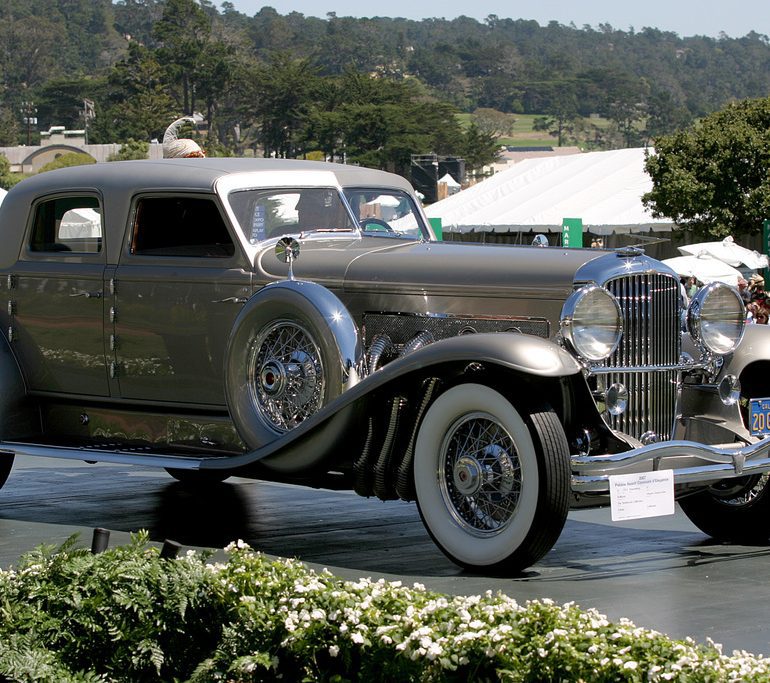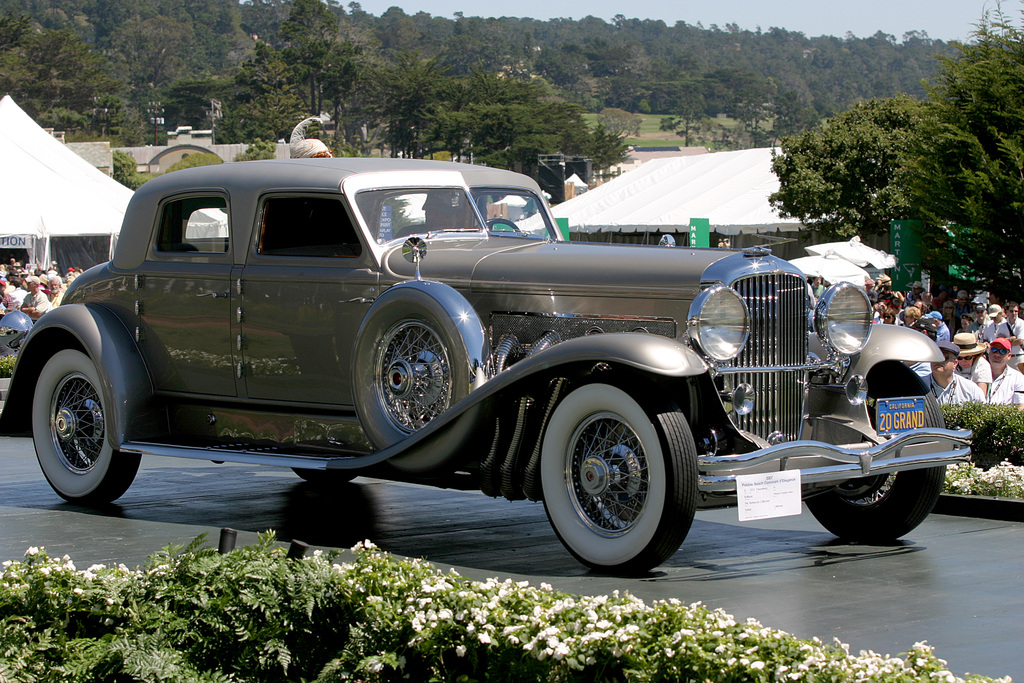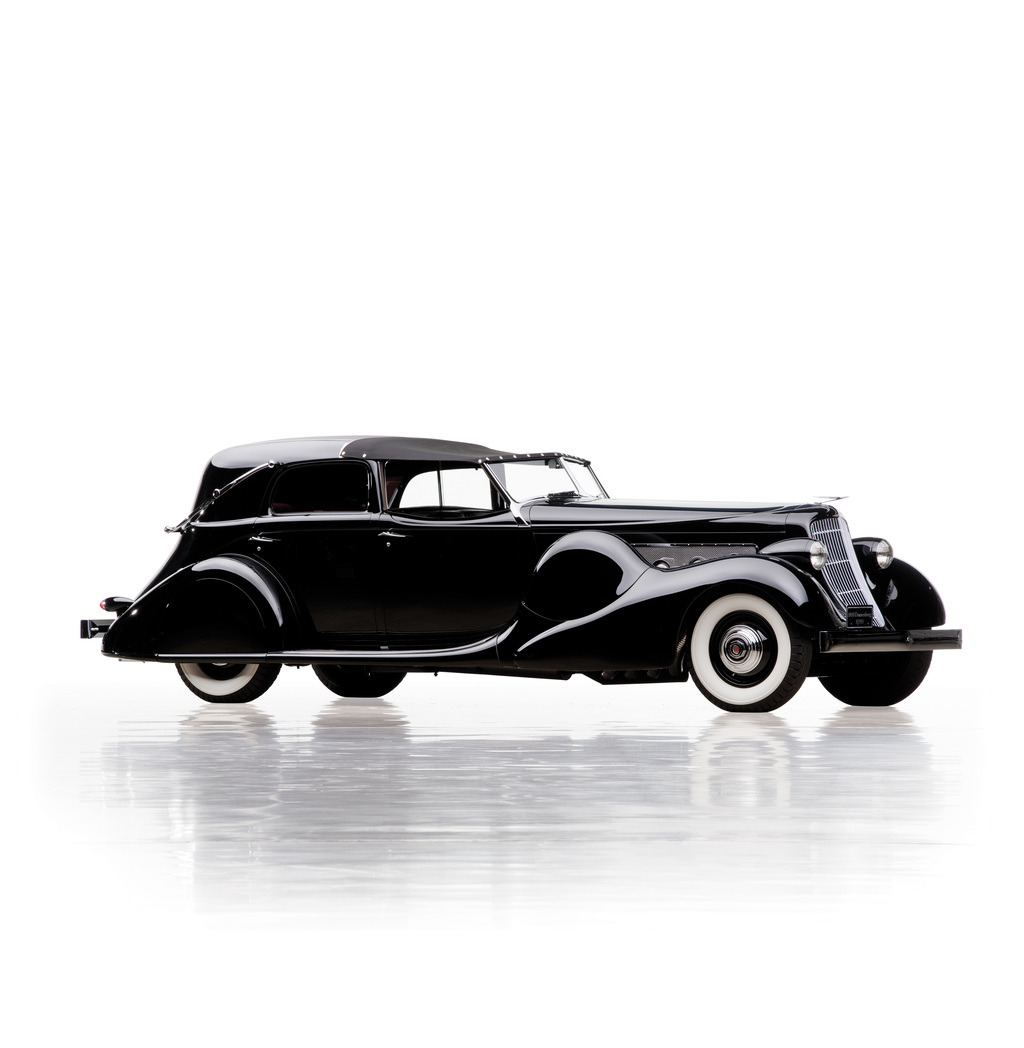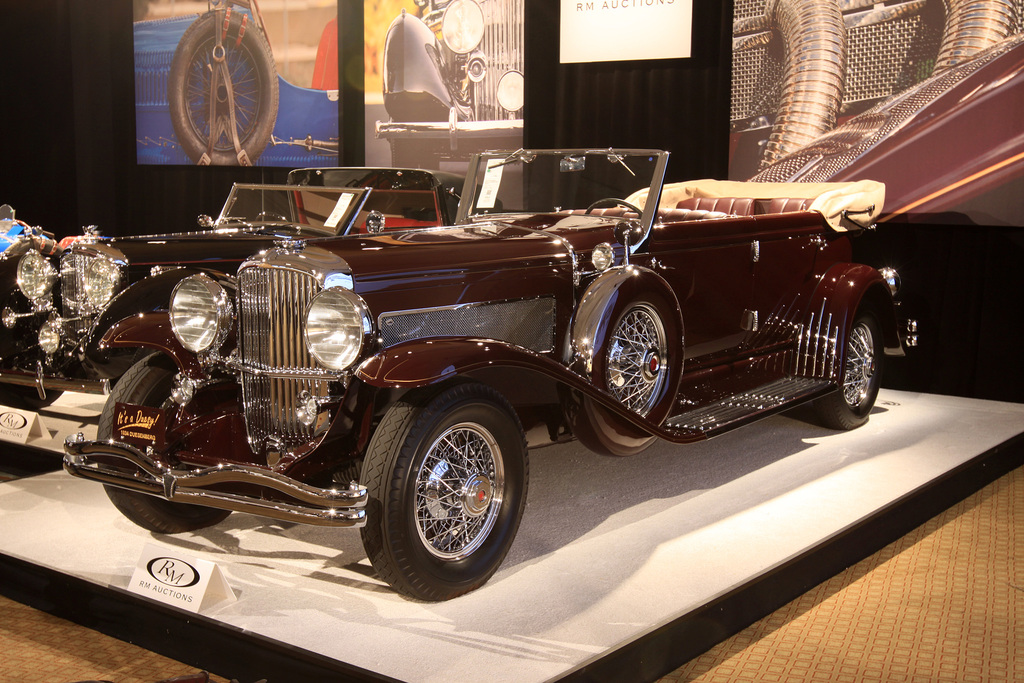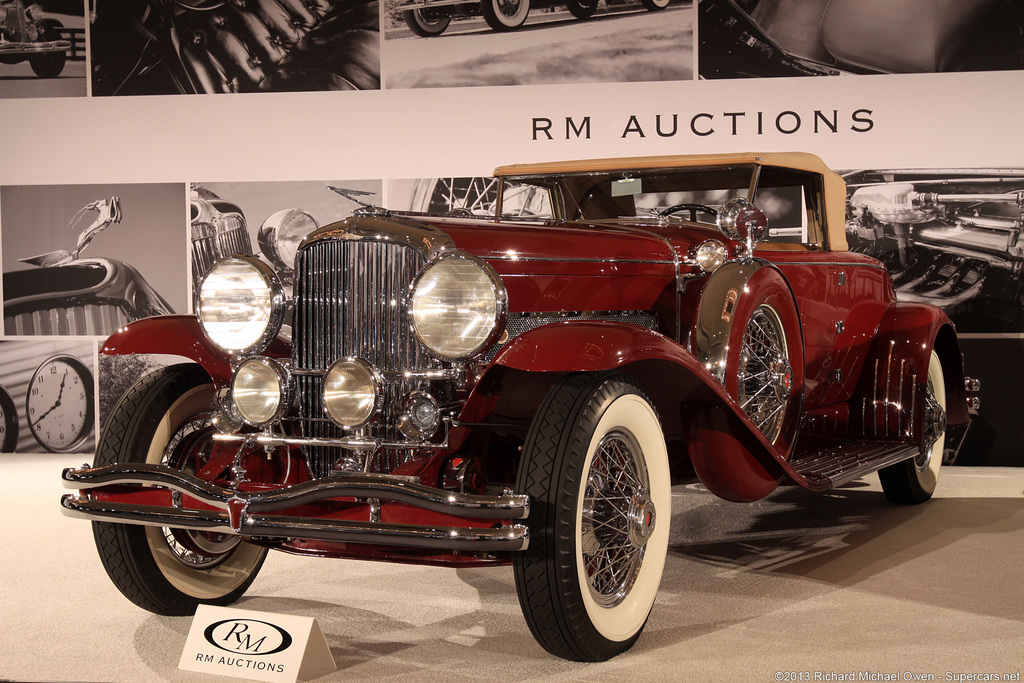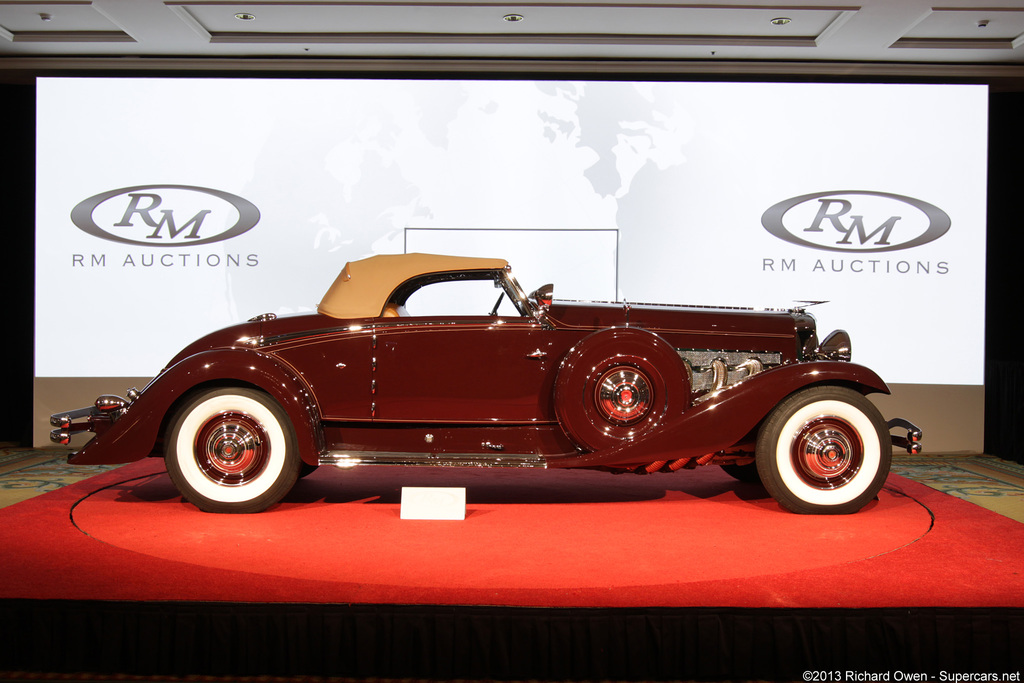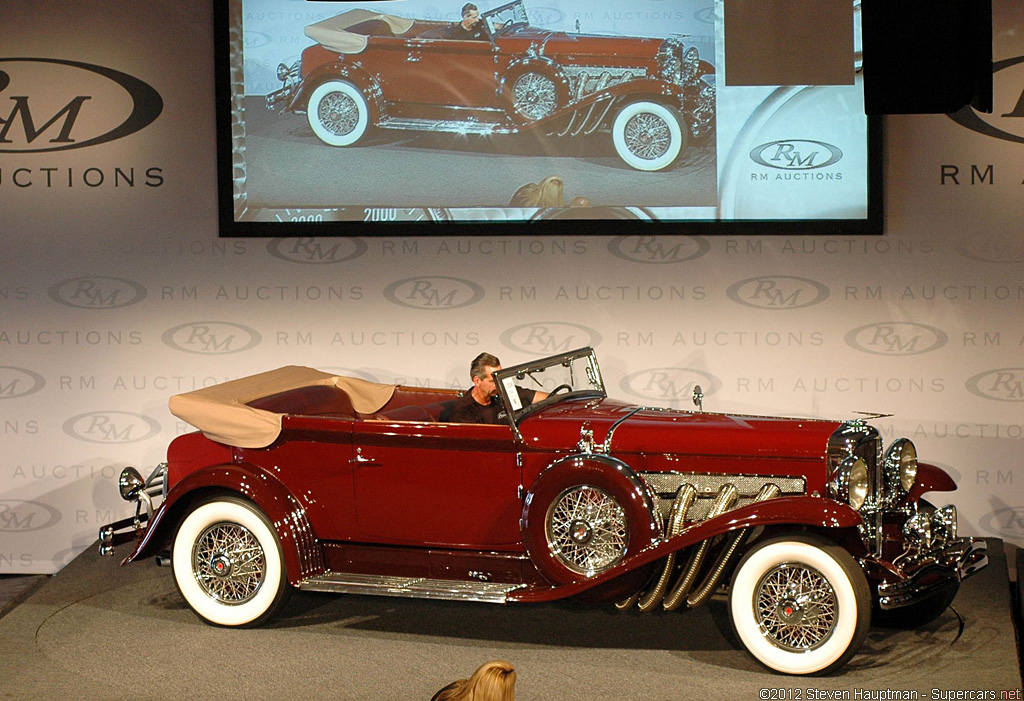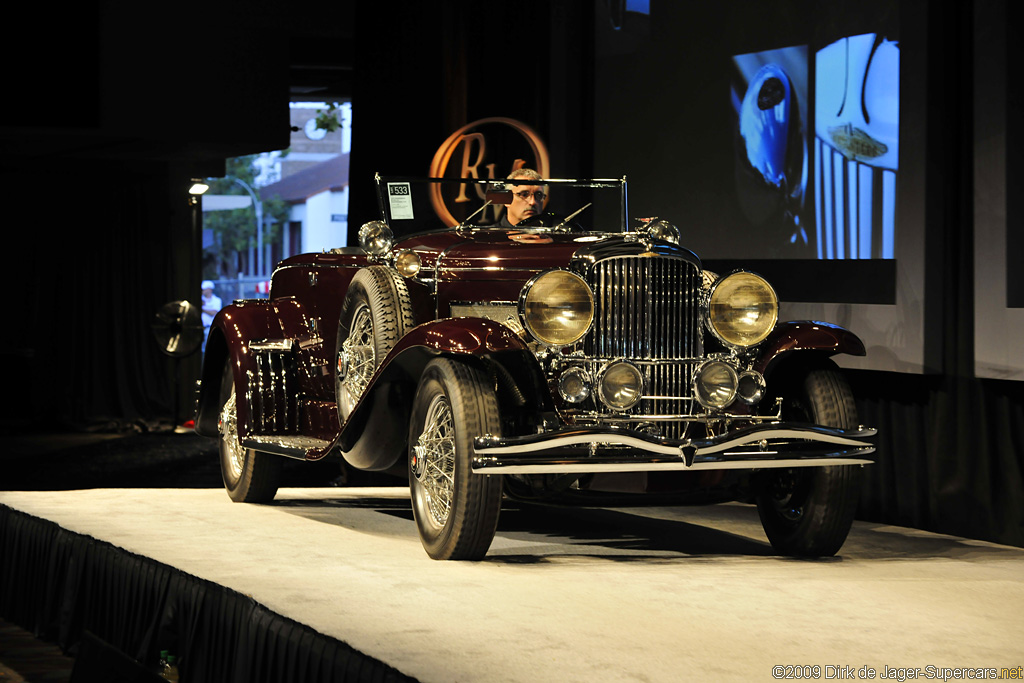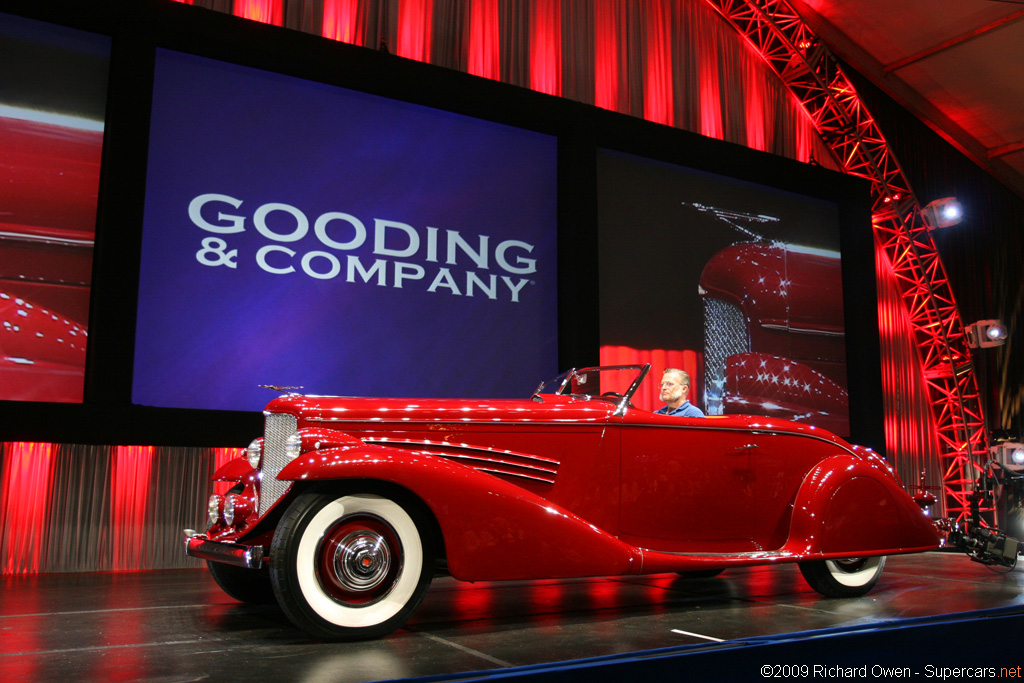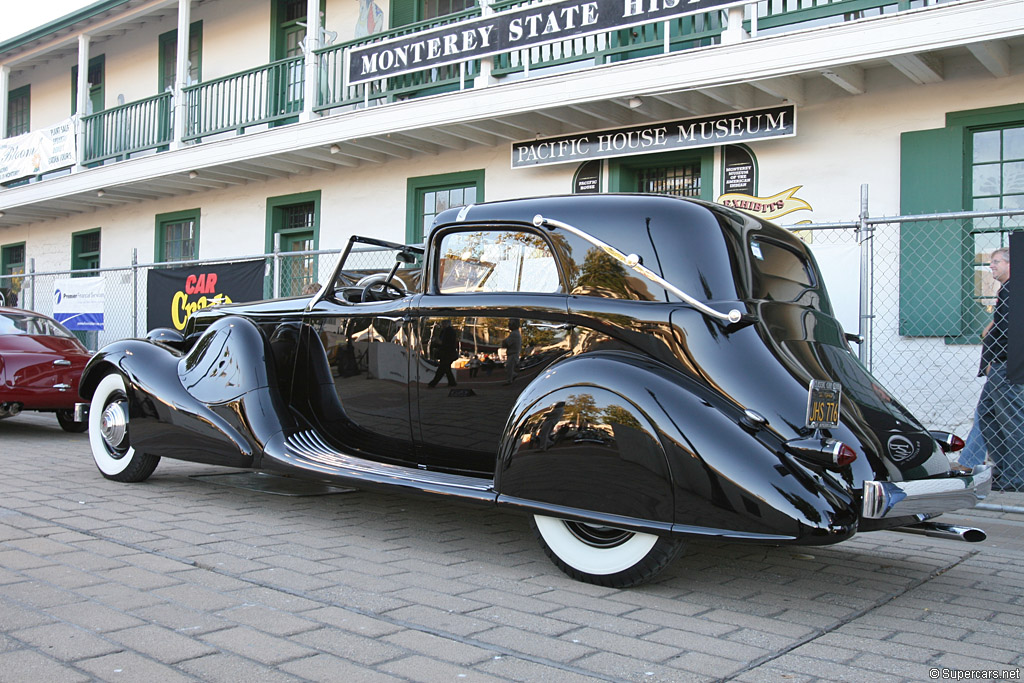1932 Duesenberg Model SJ
Supercharged Duesenbergs were the top American supercars of their time. They join the Supercharged Stutz, Cadillac V16, Packard Twelve and Marmon Sixteen to uphold American honors against the Rolls-Royce Phantom II, Bentley Speed 6, Hispano-Suiza J12 and Mercedes-Benz 540 k. With its centrifugal, gear-driven supercharger, 320 bhp was possible which eclipsed any other production car of the period.
Eric Minoff on the La Grande Dual Cowl Phaeton
The Model SJ, the supercharged version of the J, debuted in 1932 originally equipped with a set of eight separate hard pipes, the arrangement you see on this car. The early hard pipes, as they were referred to, only existed for less than a year, at which point they replaced with the 4 flexible stainless steel pipes you see on virtually all SJ and many J’s.
The stainless pipes were so racy and popular at the time (Mercedes-Benz, Maybach, Rolls Royce, Bentley, Delahaye, Delage, Talbot-Lago, Auburn, and many others all had them), that many owners actually converted their hard pipe SJ’s (or no external pipe J’s) to the 4 stainless steel pipes. While these pipes did have their advantages, such as prestige and (on SJ’s) the ability to disconnect the pipes for a [loud] boost of power, some owners liked their hard pipe SJ’s too much to change them.
One owner went so far to tell August Duesenberg (after the owner had received a notice from the company offering to change the pipes) that he loved his hard pipes b/c they glowed at night and impress my girlfriend! Hence, you can definitely tell if a Duesenberg is an SJ if it has hard pipes, but cannot if it has stainless steel ones.
In Detail
| engine | Lycoming Straight-8 |
| position | Front Longitudinal |
| aspiration | Centrifugal, Gear Driven Supercharger |
| valvetrain | DOHC 4 Valves / Cyl |
| displacement | 6876 cc / 419.6 in³ |
| bore | 95.25 mm / 3.75 in |
| stroke | 120.6 mm / 4.75 in |
| compression | 5.2:1 |
| power | 238.6 kw / 320 bhp @ 4200 rpm |
| specific output | 46.54 bhp per litre |
| bhp/weight | 122.7 bhp per tonne |
| torque | 576.22 nm / 425 ft lbs @ 2400 rpm |
| redline | 5200 |
| body / frame | Steel over Steel Ladder Frame |
| driven wheels | RWD |
| front tires | 7.00×19 |
| rear tires | 7.00×19 |
| front brakes | Drums w/Hydrualic Assist |
| rear brakes | Drums w/Hydrualic Assist |
| front wheels | F 48.3 x 17.8 cm / 19 x 7 in |
| rear wheels | R 48.3 x 17.8 cm / 19 x 7 in |
| steering | Ross Cam and Lever |
| f suspension | Rigid Axle w/Semi-Elliptic Springs, Hydrualic Shock Absorbers |
| r suspension | Live Axle w/Semi-Elliptic Springs, Hydrualic Shock Absorbers |
| curb weight | 2608 kg / 5750 lbs |
| wheelbase | 3620 mm / 142.5 in |
| front track | 1425 mm / 56.1 in |
| rear track | 1425 mm / 56.1 in |
| transmission | Warner Hy-Flew 3-Speed Manual |
| gear ratios | 2.485:1, 1.397:1, 1.000:1 |
| top speed | ~207.6 kph / 129 mph |
| 0 – 60 mph | ~10.0 seconds |
| 0 – 100 mph | ~20.0 seconds |
Auction Sales History
1935 Duesenberg Model SJ Bohman & Schwartz Town Car J553 – sold for $3,630,000 A one-off streamlined creation on a factory-supercharged chassis. Designed for Mae West; built for candy heiress Ethel Mars. Formerly owned by William Harrah and Richard Dicker. Featured in all of the important Duesenberg texts. Original engine, chassis, and body; ACD Certified Category 1 (D-044). The ultimate SJ Duesenberg.
Auction Source: Paul & Chris Andrews Collection by RM Sotheby’s
1934 Duesenberg Model SJ LeBaron Convertible Sedan J494 – sold for $1,567,500 The only SJ Convertible Sedan by LeBaron. Formerly owned by Edith Ludwig and Edmund C. Lynch Jr.Original engine, body, and chassis. Known history from new. Featured in Out West with the Hardys and Automobile Quarterly, Vol. 1, No. 1.
Auction Source: Amelia Island 2014 by RM Auctions
1931 Duesenberg Model SJ ‘Disappearing Top’ Convertible Coupe by Murphy J345 – did not sell for $1,850,000 A genuine disappearing top Murphy Convertible Coupe with original engine, chassis, and body. Painstakingly restored with a supercharger and Monel side exhaust. ACD Club Certified Category One.
Auction Source: 2013 Monterey Auction by RM Auctions
1935 Duesenberg Model SJ LaGrande Convertible Coupe J530 – sold for $4,510,000 Arguably the most beautiful convertible coupe on the Duesenberg chassis. One of three produced, and the only supercharged example. Believed equipped with an original supercharger. Formerly the property of Raymond Lutgert and General William Lyon. Driven extensively, including the Texas and Wyoming Duesenberg Tours.
Auction Source: 2013 Amelia Island by Rm Auctions
1930 Duesenberg Model SJ Convertible Victoria J272 – sold for $957,000
Owned by noted band leader Paul Whiteman of “Rhapsody in Blue” fame. Recently detailed, mechanically inspected on a limited basis, and serviced.
Now offered for the first time in over a decade, J272 marks a significant opportunity for collectors. Simply put, supercharged Duesenbergs are the Holy Grail for collectors of American classics, and J272 represents an outstanding opportunity to acquire an example with strong provenance and beautiful and distinctive Victoria coachwork by the Rollston Company.
Auction Source: 2012 St John’s by RM Auctions
1933 Duesenberg SJ Riviera Phaeton 2551 – sold for $1,430,000
A factory-supercharged Model SJ. Original Phaeton body. Today, Lt. Col. Jacob Schick’s magnificent SJ528 is one of a mere handful of original-bodied supercharged Model J Duesenbergs remaining today. It is one of three Brunn Riviera Phaetons built and, amazingly, one of two such factory-supercharged cars. In 2006, SJ528 was shown at the prestigious Amelia Island Concours d’Elegance, where it was awarded Best in Class. As expected, it is an exceedingly rare event when an original-bodied Duesenberg with the specification, pedigree, provenance and rarity of SJ528 comes to market. For the confirmed collector of the finest custom-coachbuilt cars of the Classic Era, SJ528 is very likely the finest example available today.
Auction Source: RM Auctions’ 2010 Sports & Classics of Monterey
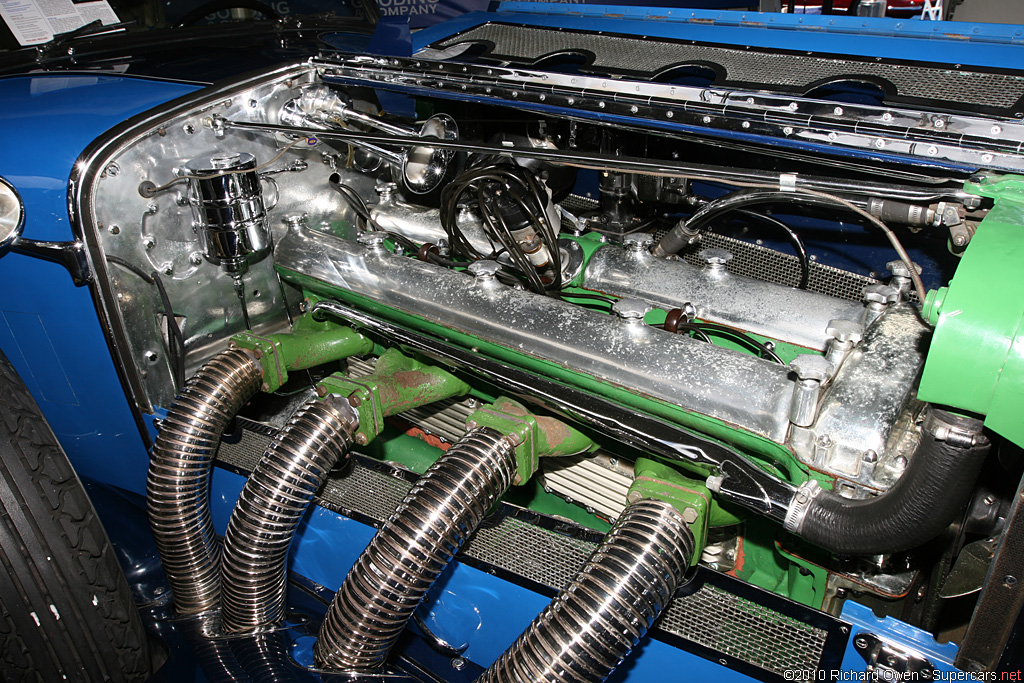
1933 Duesenberg SJ LWB Convertible Berline 2437 – sold for $671,000
This long wheelbase convertible sedan displays many of the features and design details for which the later production cars are known. The skirted front fenders give the car a more modern look, as do the 17” diameter drop-center wheels. As one of Murphy’s most popular bodies for the Model J chassis, the design was continually improved. This example has the very sporty and desirable, highly-raked windshield with Murphy’s signature ultra-thin posts, as well as the cockpit-inspired, deeply curved cowl line that continues beautifully from behind the windshield into the front doors. When it left the factory, 2437 was fitted with Marchal reflectors within the Twilite headlamp shells, an unusual factory option that the car still retains.
Every collector who has ever chased the faint hope of finding treasure at the end of a distant, unpaved driveway has dreamed of finding a forgotten Duesenberg that was stored away in a barn long ago. In the dream, dust is wiped from the master coachbuilder’s engraving on a sill plate and the serial numbers match those written years before in a well-worn spiral notebook. The Duffy SJ is one such car – one of the very last off-the-grid Duesenbergs left to be rediscovered.
Auction Source: 2010 Gooding & Company Pebble Beach Auction
1935 Duesenberg Model SJ Disappearing Top Convertible Coupe – sold for $1,430,000
While many of the finest custom coachbuilders of the era offered a truly stunning array of the finest bespoke coachwork to suit virtually any customer need or taste, the Walter M. Murphy Company of Pasadena, California is generally recognized today as the most successful coachbuilder on the Duesenberg Model J chassis. At once simple and elegant, Murphy-built bodies were distinguished by their trim lines and undeniable sporting character, seeming all the more so when compared to contemporary East Coast designs, which were generally heavier and more ornate in their concept and execution.
The trademark of Murphy body design was the “clear vision” pillar. On the convertible coupe, the windshield pillars were designed to be as slim as possible, creating a sportier, more open appearance. In fact, Murphy advertised that their windshield pillars were “narrower than the space between a man’s eyes”; a design feature that they also claimed eliminated blind spots. Without doubt, the Convertible Coupe is generally considered the best looking of Murphy’s designs and indeed, it was one of the most popular body styles for the Model J chassis.
The story of J-527, the engine now installed in Chassis 2406, begins in November of 1933 when socialite Isabel T. Pell purchased it new from the Duesenberg Factory Branch in New York. Built as a show car, J-527 (LWB chassis 2556) was originally supercharged and featured a beautiful Convertible Coupe body by Rollston. Miss Pell drove her new Duesenberg for a little more than a year before deciding to trade it in. Returning to the New York branch in 1935, she found another new Rollston-bodied Duesenberg on the showroom floor. This car, J-550 (LWB chassis 2576), carried Convertible Victoria coachwork. Miss Pell, however, loved her original Rollston-bodied Convertible Coupe, so on February 15th, 1935 she purchased J-550 and instructed Duesenberg to move her beloved original convertible coupe body to the new (normally aspirated) chassis.
The result was that Miss Pell’s original used Duesenberg chassis now wore brand-new Rollston Convertible Victoria coachwork. H. T. Ames purchased this car on March 25, 1935 and then in October that year, George A. Spiegelberg purchased it. Less than six months later, in March of 1936, William Randolph Hearst, the legendary publishing magnate, bought the car. Some time later, the car was stolen and damaged. Next, Mr. Shirley D. Mitchell purchased it during the late 1930s. At this time, Mitchell also owned J-401, chassis 2406, a short-wheelbase Murphy Convertible Coupe, whose engine had been used in the restoration of a Castagna-bodied Convertible Sedan.
As a result, while restoring the now-engineless Murphy Convertible Coupe, Chassis 2406 in the late 1930s, Mitchell decided to install the supercharged engine from J-527, with the car remaining in this configuration ever since. At this point, the car was sold to Cuban diplomat Norberto Angones Quintana, who took the car with him to Cuba and then in 1939, Quintana accepted a post as First Secretary of the Cuban Embassy in Paris, bringing J-527 with him. In September 1940, he was issued a certificate from the German Military Occupation Administration, permitting him to drive his Duesenberg on holidays and weekends! (A copy of this certificate accompanies the car today). As these operating permits were available only to diplomats, J-527 was accordingly registered during this period on French diplomatic plates bearing the number CD 355X.
In 1941, Quintana was transferred to Cuba’s Spanish Embassy in Madrid, and once again, J-527 accompanied him. At some point after his arrival in Madrid, he sold the car to two brothers, Miguel and Jose Maria Arechavala of Spain. Next, the car was purchased by Pericao Gandarias, a wealthy businessman from Bilbao, Spain. While the timing cannot be established precisely, it is well known that during its time in Spain, the original supercharger was removed from J-527 and replaced with a standard intake manifold.
In a further twist worthy of a Hollywood script, John Ward, a retired U.S. Marine Sergeant who had married a Spanish girl and was running a bar in the resort area of Palma de Mallorca, became the next owner. According to a letter from Nicolas Franco, he and Rafael Estavans learned that Ward had cash flow problems caused by a number of large unpaid bar tabs that were incurred by U.S. Navy sailors. In a remarkable story, one night Franco and Estavans struck a handshake deal with Ward to buy the car for the total of all the unpaid bar tabs – which, when tallied up, amounted to $2,800!
Later, in the early 1960s, Estavans sold his half-interest in the car to Nicolas Franco, Jr. An extensive file of correspondence with Duesenberg historian Ray Wolff documents Franco’s efforts to correct some errors contained in a story on the car published within the Auburn-Cord-Duesenberg Club newsletter. While Franco owned J-527 for several years, he apparently became interested in selling the car in 1971, when he was asking $35,000. By 1975, he still owned the car, when Jerry Whittaker, an A-C-D club member, wrote to Ray Wolff and reported visiting Madrid in an unsuccessful attempt to buy the car.
Finally, on December 5, 1976, Franco sold the car to Archie Meinerz, who undertook a comprehensive restoration and retained J-527 for nearly 15 years before selling it to Al Webster, a noted Canadian collector, in February 1990. Webster recalls that the car was in very good condition and during his ownership, he corrected only small flaws and details, although he did commission Duesenberg expert Brian Joseph of Detroit to perform a full engine rebuild. During the rebuild, the internal upgrades required for supercharging were found to be present and accordingly, the engine was rebuilt with the intention that a supercharger would be reinstalled.
After showing J-527 at the Meadow Brook Hall Concours d’Elegance in August 1992, Webster sold the car to Robert Gottlieb in November that same year. Gottlieb entrusted the maintenance of the car California-based Duesenberg restorer Randy Ema and on November 11, 1993, A-C-D Level 1 Certificate number D-074 was issued. Gottlieb kept J-527 until March 2000, when New York-based collector Piers MacDonald acquired it. During MacDonald’s tenure, he commissioned the well-respected, award-winning Stone Barn firm of Vienna, New Jersey to repaint the body and fenders, trading the previous two-tone red paintwork for a single shade of Dark Garnet Red. New brakes, a new top and new 19-inch chrome wheels were also installed and then J-527 was shipped back to Brian Joseph in Detroit to have the transmission rebuilt and the car prepared for the 2002 Fall Auburn-Cord-Duesenberg Club meet.
In August 2003, J-527 was sold to Chris Gruys, who decided to return the engine to supercharged form, with the necessary work performed by RM Auto Restorations. A new and correct supercharger, one of 10 precise reproductions of the original units, was obtained from Leo Gephardt and Brian Joseph, complete with the ultimate high-performance “ram’s horn” manifolding. During the supercharger installation, the RM team fabricated all of the required brackets, lines and drive assemblies, removing the oil plugs that were added to the engine block and cylinder head when the original supercharger was removed during the process. Once the supercharger installation was complete, the engine was tuned and the mechanical systems were inspected and serviced while the cosmetics were freshened.
Next, the Duesenberg was sold through RM Classic Cars to collector Steve Schultz, who later sold J-527 to the current owner, an East Coast-based private collector. Today, the Duesenberg continues to be highly presentable throughout, complemented by many period correct features including side mounted spare tires, dual Pilot-Ray lamps, cowl lamps, dual “Sport Light” spotlights, dual trumpet-style horns, dual taillights (one optional) and a polished aluminum luggage rack. With its stunning open Murphy coachwork, fascinating history and powerful supercharged engine, this well-sorted and extremely rare automobile stands ready to write a new chapter with a new owner.
Auction Source: 2009 RM Auctions Sports & Classics of Monterey
1935 Duesenberg Model SJ Bohman & Schwartz Roadster – sold for $3,300,000
This model SJ Duesenberg, chassis number 2596, was built for Russian Prince Serge M’Divani, an aristocrat and marital ‘opportunist.’ Its Bohman & Schwartz-built body is unique in design. A one-of-a-kind, the car has numerous recognizable Bohman & Schwartz styling ideas. The car is believed to have been bought for Prince M’Divani by Barbara Hutton, heir to the Woolworth fortune. Not long after M’Divani’s death in a polo accident, the car was acquired by automotive engineer Jerry Gabby, who, during his thirty years of ownership, raced the car up Pikes Peak and had other road exploits including a drive from Dayton, Ohio, to Tucson, Arizona, much of it at speeds well above 100 mph.
Auction Source: 2009 Gooding & Company Pebble Beach Auction
1935 Duesenberg Model SJ Bohman & Schwartz Town Cabriolet – sold for $4,400,000 Considered the most beautiful formal town car of the period, this outstanding one-off creation was penned by Christian Bohman and Maurice Schwartz. Commissioned by Mars Candy Company heiress Ethel Mars, SJ553 is one of just 36 factory supercharged Duesenbergs, and one of the few to retain its original coachwork, drivetrain, and chassis. It remains a superlative example of the art of custom coachbuilding in America.
Auction Source: 2007 Monterey Preview


